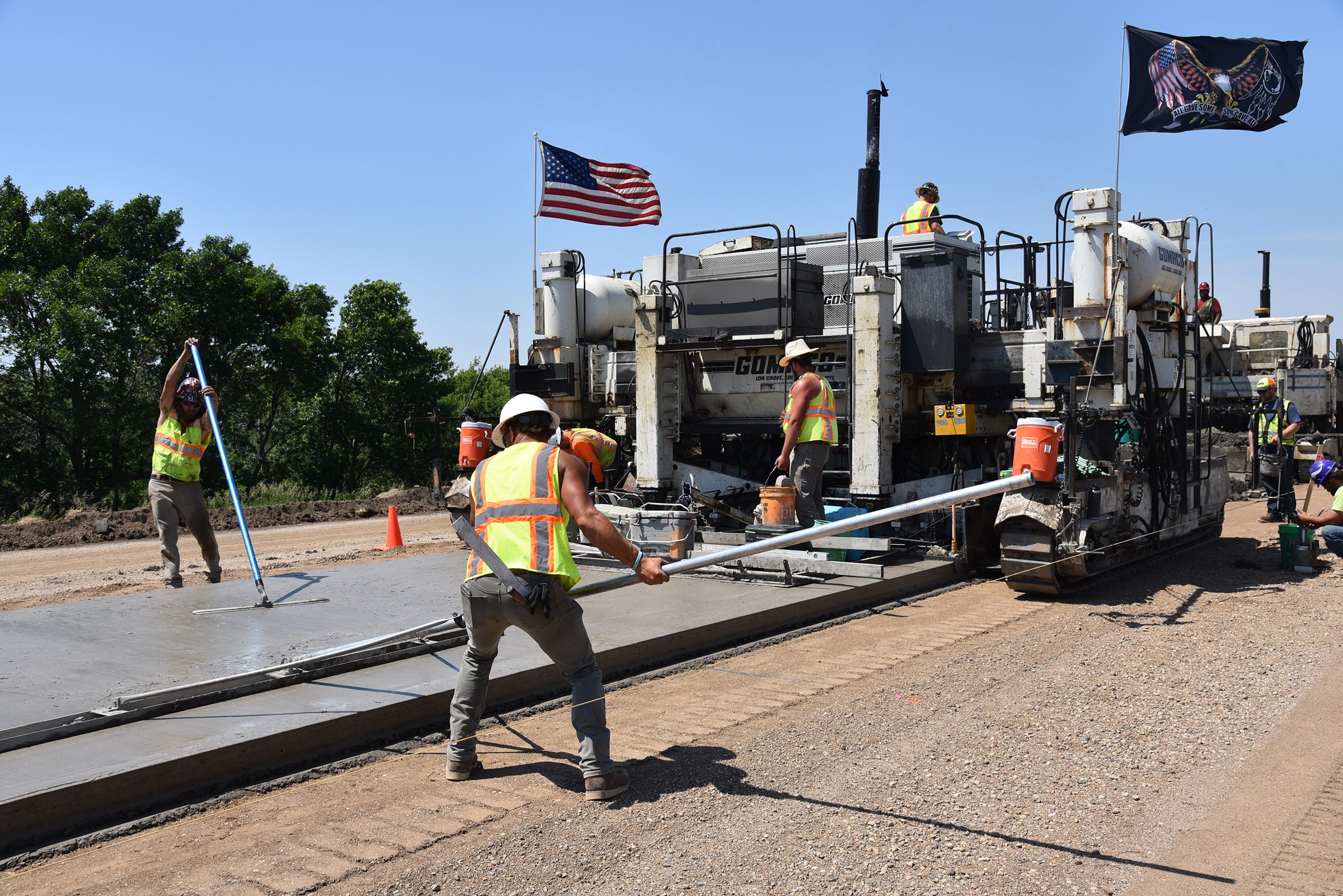 |
|

|
 |
TABLE of CONTENTS
 |
Missing the 'Great Minnesota Get-Together' |

At left, MnDOT photographer Rich Kemp, in green, and delivery van driver Jerry Hallis move 'Work Zone Charlie Brown' during setup for the agency's booth at the 2016 Minnesota State Fair. At right, a MnDOT plow truck and employee participate in a parade at the 2019 fair. Photos by MnDOT staff |
|
By Joseph Palmersheim
Like many Minnesotans this year, MnDOT is missing the “Great Minnesota Get-Together.” To celebrate what would have been, we are sharing throwback State Fair photos from years’ past on our social media channels during the next week. Not following us on Facebook yet? Find us here.
Did you know? According to mnstatefair.org, “Since its inception, the fair has been held every year with only six exceptions: in 1861 and 1862 due to the Civil War and U.S.-Dakota War, in 1893 because of scheduling conflicts with the World’s Columbian Exposition in Chicago, in 1945 due to federal government travel restrictions during World War II, in 1946 due to a polio epidemic, and in 2020 due to the COVID-19 pandemic.”
|
|

|
 |
TABLE of CONTENTS
 |
Concrete paving complete on Hwy 210 west of Fergus Falls |
By Emma Olson, District 4 Public Affairs

Crews smooth out the fresh concrete pavement on Hwy 210 west of Fergus Falls. Photo by Emma Olson |
Concrete paving wrapped up earlier this month on Hwy 210 west of Fergus Falls, which allowed District 4 construction staff to finally take a breath. Although the two-lane highway has been closed since May for construction, local traffic use made crews a little nervous during paving operations.
“The project includes just over five miles of concrete paving, most of which has been done full-width,” said Katy Reierson, project engineer. “With the high volumes of local traffic that need access to the highway, it felt like we were sitting on the edges of our seats until it cured.”
For the 2020 project, crews are reconstructing Hwy 210 from just west of Interstate 94 in Fergus Falls to east of the Otter Tail/Wilkin county line. Grading and paving for the $13.8 million project were completed in stages to minimize local access impacts. In one section of the highway, paving was completed half at a time to accommodate higher volumes of local traffic.
“We knew the east side of the project would be hard to do full-width because of its proximity to I-94, Walmart and other large-scale operations that needed full-time access,” Reierson said. “The prime contractor has been responsible for creating access management plans at every stage of construction, and they’ve done a great job setting up traffic control and communicating changes to residents and businesses.”
Construction on Hwy 210 is expected to wrap up by mid-September. In addition to concrete resurfacing, the project also includes shoulder widening on the west end of the project, construction of a truck inspection lane, turn lanes and bypass lanes at various intersections, and installation of snow fences and ditching to address blowing and drifting snow concerns. Several local road entrances have also been paved, at city cost.
Learn more by visiting the project website: mndot.gov/d4/projects/hwy210.
|
 |
|

|
 |
TABLE of CONTENTS
 |
New plans identify needs, develop resources for freight projects statewide |
By Andrew Andrusko, Office of Freight and Commercial Vehicles
The Office of Freight and Commercial Vehicle Operations is working with MnDOT staff statewide to identify freight needs and develop project resources for freight projects across the state through District Freight Plans.
As a follow-up to outreach efforts to manufacturers in the Manufacturer Perspectives’ Studies, the District Freight Plans are looking at ways to prioritize freight needs and connect freight elements into future construction projects. Each plan collects 26 different kinds of freight data, which is combined with public input and mathematically analyzed using a model created to rank and prioritize freight needs into a numerical list.
In the context of the plans, “freight needs” primarily means asking what roadway, railway, port or airport improvements are needed over the next 10-20 years. The plans primarily focus on highway and rail freight movements, but may also include discussions around freight by any mode of travel including airplane, pipeline, ports and waterways or others.
“Within the planning process, we also ask about strategic or regional issues that cannot be solved by infrastructure alone,” said Bill Gardner, director, Office of Freight and Commercial Vehicle Operations. “For example, if there is a need for more competitive freight rates in a certain region or if there is a labor shortage in a specific sector. These are included in a strategic policy section of each plan.”
The office’s freight planning team is working in collaboration with staff from each district, and already completed the first of these plans for District 1 in early January. Additional efforts are now underway in Districts 2, 3 and 8. As project teams complete each plan, districts are using feedback on needs identified in freight plans to form the basis of potential projects submitted to the recently released second round of the Minnesota Highway Freight Program solicitation.
The freight program will have up to $56 million available to fund key freight projects and address freight bottlenecks on highways statewide. The bottlenecks are locations that experience congestion, low travel speeds and a wide range of travel times.
The end of result of these planning efforts aim for better integration of freight into MnDOT’s regular operations at the district level, as well as laying further groundwork for MnDOT’s update to the Minnesota State Freight Plan. The district freight plans will also help inform MnDOT leadership on how to respond to freight issues across the state.
“Efficient freight movement is critical for the thousands of Minnesota businesses moving their products, as well as consumers, who now more than ever depend on the reliable delivery of goods to stores and their homes,” Gardner said.
|
| |
|

|
 |
TABLE of CONTENTS
 |
How to stop an ‘email storm’ created by unwanted replies |
By Joseph Palmersheim
We’ve all been there – CC’d on an email chain that, thanks to people choosing “reply all,” takes over our inbox.
These reply-all events, called “email storms,” can affect a workday in several ways. When they are large enough (number of people, large attachments, etc.) they can impact performance and capacity of email servers. The never-ending stream of replies can also distract everyone who is receiving them.
Reply-all is a useful tool for small to medium sized groups – but it isn’t one that should be used by everyone, according to Bob Bennett, MNIT@dot.
“Unless your job is communicating to large groups, don’t,” Bennett said. “If you have a comment on the email, contact the sender directly and let them know your thoughts so they can decide how to handle your new information.”
If your job is to communicate to large groups:
- Consider using the “BCC” field for recipients. Reply-all won’t go to these.
- Include a “please do not reply all” statement at the beginning of the email.
- Consider using a list server, which sends out large batches of single emails and can filter replies.
If you find yourself in a reply-all chain, the “Ignore Conversation” option in Microsoft Outlook will move any messages in the conversation to the Deleted Items folder, and any new messages in that conversation will go directly to the Deleted Items folder.
To access the “Ignore” feature, right-click on the email in question, select “Ignore” from the menu that pops up, and confirm. While this function will keep you from seeing the reply-all storm, it won’t stop the reply-all chain from affecting other users.
Here are a few more email etiquette tips:
- Read the entire email and know who is on the recipient list before hitting the reply-all button. We have all done the reply-all only to realize later it was going to people we didn’t intend or that we missed an important point by not reading the entire email or skimming it.
- Make your point as succinctly as possible so readers don’t have to wade through lots of detail. Try to anticipate and address questions to avoid the need for replies.
- Emails can be misinterpreted/misread. It’s your job to be extremely clear and concise to prevent misinterpretation by your readers.
- Use email only when you really need to. Keep conversations on instant message. Skype (currently available to MnDOT staff) and Microsoft Teams (future Skype replacement) offer better ways to handle the quick, informal conversations that normally clutter up our email boxes.
|
| |
|

|
 |
TABLE of CONTENTS
 |
Unpaid leave, phased retirement options offer schedule flexibility for employees, budget savings for state |
MnDOT recently announced two new opportunities for employees to create some flexibility in their work schedules while helping to reduce costs for the state as it faces tight budget challenges. Employees may now request to temporarily reduce hours in a way that best meets their needs or participate in a phased retirement.
Salary Savings Leave
This voluntary program is an option to take unpaid leave for the number of hours and schedule (provided one’s supervisor approves the arrangement and the work of the unit can be managed). Here’s more information:
- Employee eligibility. All employees are eligible to apply. If you apply, it does not guarantee that the request can be approved.
- Salary Savings Leave is unpaid. Employees receive pay only for hours worked; the rest is unpaid. Employees are not eligible to collect unemployment benefits.
- Time accruals continue. Employees continue to earn vacation and sick time at their normal rate, regardless of the leave. Employees are also eligible for holiday pay during this time.
- No impacts to insurance eligibility. Using Salary Savings Leave does not impact an employee’s insurance eligibility, and the employer contribution continues as if the employee worked the leave hours. The employee portion of insurance deductions will continue to be withheld from the employee’s reduced salary. If the employee’s salary is insufficient to cover their portion of insurance deductions, the employee will be billed separately for insurance while on SSL.
Learn more about the Salary Savings Leave in HR/LR Policy 2014-3, or download the Salary Savings Leave Employee Request Form.
Phased Retirement Program
This is currently available to employees in MAPE, MMA and the Commissioner’s and Managerial Plans. However, AFSCME and MGEC employees should still apply if they are interested; Labor Relations can pursue an MOU with the union to allow this program. A supervisor would need to approve an employee’s request and manage the work of the unit.
- Employee eligibility. Employees must be full-time employees who have reached the age of 55 or more, have 10 or more years of continuous state service, and have given written notice of their retirement date. Employees must work at least 50 percent and the retirement date must occur within six months or less of the date of the request and approval. The highlights of phased retirement are:
- No impacts to insurance coverage. Phased retirement does not affect an employee’s insurance eligibility.
- Time accruals continue. Employees continue to accrue vacation or sick leave time at the normal rate. Employees are also eligible for holiday pay during this time.
- Service credit. Employee will continue to earn service credit toward retirement; however, earnings do affect an employee’s high five.
Download the Phased Retirement Request Form.
Employees interested in participating are asked to submit the appropriate form to their supervisors by Friday, Aug. 28. Bequests made after that date will still be accepted, but more time will allow supervisors to review the workforce requests, make approvals, and plan for how the work can be performed.
MnDOT plans to run these programs through Dec. 31, and at that time, will re-assess any continuation of the program. Contact your supervisor or the Human Resources office with any questions.
|
| |
|

|
 |
TABLE of CONTENTS
 |
Library news: ASTM DOT Compass Portal webinar on Aug. 25 |
Did you know? MnDOT employees can access individual American Society for Testing and Materials standards and specs from the American Association of State Highway and Transportation Officials Materials Book via the ASTM DOT Compass Portal. A representative will offer a one-hour virtual training for MnDOT portal users at 2 p.m. Tuesday, Aug. 25. The webinar will be recorded for those unable to attend.
New library materials are now available. In addition to the list of newly cataloged materials by subject, this issue features standards and specifications. Contact library staff at library.dot@state.mn.us with any questions or feedback.
|
| |
|

|
 |
TABLE of CONTENTS
 |
‘Pathways to Decarbonizing Transportation’ report earns national award |
By Mary McFarland Brooks
The MnDOT Office of Sustainability and Public Health recently received a Notable Document Award from the National Conference of State Legislatures – Legislative Reference Librarians.
Molly Riley, reference librarian at the Legislative Reference Library in St. Paul, nominated the report for the award.
“Because of our role as the state document depository, we see many, many documents throughout the year,” Riley said. “MnDOT’s Pathways to Decarbonizing Transportation in Minnesota report caught our eye for its detail, the unique public engagement process behind the report and its usefulness to other states as they address similar issues.”
According to Riley, nominations for the award can be made by anyone, but usually come from state agencies themselves or from legislative librarians around the country.
MnDOT earned its first NCLS award in 2018 for the Minnesota Tolling Study Report. The 2020 Pathways to Decarbonizing Transportation in Minnesota report is the second time the agency has honored.
|
| |
|

|
 |
TABLE of CONTENTS
 |
Staffing updates |
By Mary McFarland Brooks

Sean Skibbie. Photo by Jordan Gilgenbach |
Sean Skibbie is the new operations program manager in the Office of Civil Rights. No stranger to the agency or to the Civil Rights Office, Skibbie worked both as an intern while attending law school and later in contract compliance for the Civil Rights office from 2014-16. Most recently, Skibbie has been working for the city of Minneapolis in the areas of labor, workforce and contract compliance in their Civil Rights office.
Skibbie said he is glad to be back at MnDOT.
“The agency is exceptionally productive, positive and effective, which makes MnDOT a great place to be,” he said. “I wish I could bottle the culture here.”
As operations program manager, Skibbie will oversee supportive services and contract compliance.
“I am so pleased to have Sean rejoin the Civil Rights team. He has both the leadership skills and the technical understanding of what we do to be a real asset to the organization,” said Kim Collins, director, Office of Civil Rights. “I look forward to working with Sean as we re-examine our programs and processes to promote equitable outcomes in transportation for the state of Minnesota.”
Skibbie graduated from the University of Minnesota with a political science degree and earned his law degree from William Mitchell College of Law.
|
| |
|

|
 |
TABLE of CONTENTS
 |
On the Job: Carmen DeMars brings commercial construction experience to MnDOT |
By Rich Kemp

Carmen DeMars. Photo by Rich Kemp |
Carmen DeMars works as a transportation generalist in the Mendota Heights Construction Office. She has been with MnDOT since May 2019. Prior to that, she worked as a project coordinator in the commercial construction industry.
“I started in 2003 working for the general contractor on the IKEA store at the Mall of America, which was super exciting because I was able to go right onto the job site to watch how the whole process works,” DeMars said. “I was hooked.”
What do you do in your job?
My job consists of measuring, documenting, testing and observing all of the activities going on at the job sites. Also, I ensure that the contractors are completing their work in accordance with the plans and specifications. I am a construction inspector, currently working on the Robert Street Bridge. My next project will be working as an inspector for the replacement of some of the dynamic message signs.
What is your favorite part about your job?
My favorite part of the job is learning new things every day. I also enjoy getting to know the contractors, what their specific job entails and how the trades work according to the schedule.
What are the biggest challenges?
The biggest challenges are those unanticipated situations or scenarios. They keep us on our toes and we need to utilize our resources and communication skills to deal with them efficiently and effectively.
What kind of changes have you seen in your job?
Most of the changes I’ve seen so far have been technology related, whether it be new industry software or updated procedural/field changes. I’ve love every minute of my job and look forward to coming to work each day.
Do you or a co-worker have an interesting job to share with readers? Send us your ideas, and we’ll contact you for more information.
Recent employee profiles:
|
| |
|
| |
|



